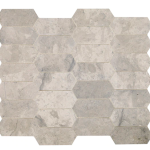Is marble advisable for construction?
Marble can be used for construction, but whether or not it is advisable depends on various factors.
Marble is a natural stone that is valued for its beauty, durability, and ability to take a polish. It has been used for thousands of years in architecture, sculptures, and decorative arts. Marble is a popular choice for countertops, flooring, and walls in modern construction projects.
However, there are some considerations to keep in mind when using marble in construction. Marble is a porous material, which means it can stain or etch when exposed to certain substances, such as acidic foods or cleaning products. It is also relatively soft compared to other natural stones, which means it can scratch or chip more easily.
Marble is also more expensive than some other building materials, and it requires specialized tools and expertise to install properly. Additionally, marble can be heavy, which may require additional structural support in some applications.
In summary, while marble can be used for construction, it may not be the best choice for every project. It is important to carefully consider the pros and cons of using marble and consult with a professional to determine whether it is the best material for your specific needs.

What is the use of marble in construction?
Marble is a versatile material that can be used in various ways in construction. Here are some common uses of marble in construction:
- Flooring: Marble is a popular choice for flooring because of its beauty, durability, and easy maintenance. It is used in both residential and commercial settings and can be installed in a variety of patterns and colors.
- Countertops and Vanities: Marble is also a popular choice for countertops and vanities in kitchens and bathrooms. It provides a luxurious and elegant look to the space and is available in a range of colors and patterns.
- Walls and Backsplashes: Marble can be used to create stunning feature walls and backsplashes in homes and commercial buildings. It can be cut and polished to create intricate designs and patterns.
- Staircases: Marble stairs can add a touch of luxury and sophistication to any building. Marble stairs are durable and can withstand heavy foot traffic, making them ideal for commercial buildings.
- Statues and Sculptures: Marble has been used for centuries to create beautiful statues and sculptures. It is a preferred material for artists due to its ability to be carved and shaped easily.
- Fireplaces: Marble is a popular choice for fireplace surrounds and mantels. It provides an elegant and classic look to the room and is available in a variety of colors and finishes.
Overall, marble is a versatile material that can be used in various ways in construction, adding beauty and luxury to any project.

Is marble better than concrete?
Whether marble is better than concrete depends on the specific application and the desired properties for the construction project.
Marble is a natural stone that is highly valued for its beauty, durability, and ability to take a polish. It is a premium material that is often used for luxury projects, such as high-end homes and commercial buildings. Marble is also relatively resistant to heat and can maintain its appearance for decades with proper care.
Concrete, on the other hand, is a man-made material that is versatile and widely used in construction. It is a popular choice for foundations, walls, and floors because of its strength, durability, and relatively low cost. Concrete is also fire-resistant and can be designed to withstand various weather conditions and loads.
Both marble and concrete have their advantages and disadvantages, and the choice between the two depends on the specific requirements of the project. Marble is typically more expensive than concrete and requires more specialized tools and expertise to install. Concrete, on the other hand, may not have the same level of aesthetic appeal as marble and may require additional finishing work to achieve a desired appearance.
In summary, marble and concrete each have their own unique properties that make them suitable for different types of construction projects. It is important to carefully consider the specific requirements of the project and consult with a professional to determine the best material for the job.
What is the only problem with using marble as a building stone?
One of the main problems with using marble as a building stone is that it is a relatively soft and porous material compared to other natural stones such as granite or quartzite. This means that it can be more prone to scratches, chips, and staining. Marble is also more susceptible to acid etching from exposure to acidic substances such as citrus juice, vinegar, or certain cleaning products.
In addition, the porosity of marble can make it more prone to damage from exposure to water and moisture. Over time, water can seep into the stone and cause it to crack or deteriorate. This is especially true in areas with freeze-thaw cycles, where water can expand and contract within the stone, leading to damage.
Another challenge with using marble as a building stone is that it is a premium material that can be expensive and difficult to source in large quantities. It also requires specialized tools and expertise to install properly, adding to the overall cost of the project.
Despite these challenges, marble remains a popular choice for construction and interior design projects due to its beauty, durability, and unique characteristics. However, it is important to carefully consider the specific requirements of the project and consult with a professional to determine if marble is the best material for the job.





